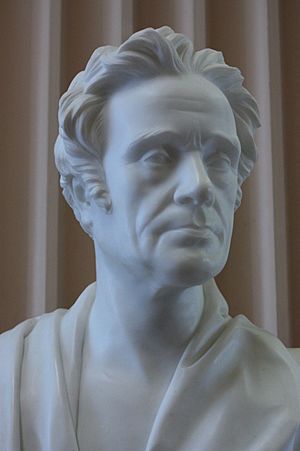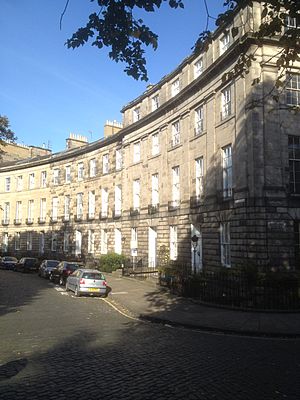Robert Jameson facts for kids
Robert Jameson (born July 11, 1774 – died April 19, 1854) was a famous Scottish naturalist and mineralogist. He taught at the University of Edinburgh for 50 years. During his time there, he helped grow the university's collection of minerals and fossils into one of the biggest in Europe. He was also known for his advanced studies and his ideas about how the Earth was formed.
Contents
Early Life and Education
Robert Jameson was born in Leith, Scotland, on July 11, 1774. His father was a soap maker. Robert first went to Leith Grammar School. Later, he became an apprentice to a surgeon, planning to work on a ship.
When he was only 15, in 1789, he took a trip to Shetland to study its geology, which is the study of rocks and the Earth. He published his findings in 1793.
He then studied medicine, botany (plants), chemistry, and natural history at the University of Edinburgh. By 1793, he decided to focus on science, especially geology and mineralogy, after being inspired by his professor, John Walker.
In 1800, Jameson spent a year in Germany, studying with a famous geologist named Abraham Gottlob Werner. This experience greatly influenced his scientific ideas.
Becoming a Professor
In 1804, Robert Jameson became the Professor of Natural History at the University of Edinburgh. He held this important job for 50 years!
He became a leading supporter in Britain of the "Wernerian geological system," also known as Neptunism. This theory suggested that all rocks, including those that looked like they formed from volcanoes, were actually laid down by a huge, ancient ocean.
At first, this idea was different from another theory called Plutonism, which was supported by James Hutton. Plutonism suggested that rocks were formed by heat and processes deep inside the Earth, like volcanoes. Over time, Jameson became more open to combining ideas from both theories.
As a teacher, Jameson had a lot of knowledge, but some students, like Charles Darwin, found his lectures a bit dry. Darwin later said that Jameson's classes made him decide "never to attend to the study of geology." However, Jameson's detailed teaching covered many topics, including the "Origin of the Species of Animals," which was a very advanced idea for his time.
Building a Great Museum
During his 50 years as a professor, Jameson collected a massive number of specimens for the University of Edinburgh's museum. These included minerals, rocks, fossils, birds, and insects. By 1852, the museum had over 74,000 items! It was the second-largest natural history collection in Britain, after the British Museum.
After he passed away, the university's museum collection was moved and became part of the Royal Scottish Museum, which is now the Royal Museum in Edinburgh.
Jameson also wrote many scientific papers and books. Some of his important works include Mineralogy of the Scottish Isles (1800) and his System of Mineralogy (1804). He also helped start and edit the Edinburgh Philosophical Journal.
Robert Jameson died in Edinburgh on April 19, 1854.
Notable Students
Many students learned from Robert Jameson, including:
Family and Legacy
Robert Jameson never married or had children. However, his family included other notable scientists. His nephew, Thomas Jameson Torrie, was also a geologist. Another nephew, William Jameson, became a famous botanist in India.
A type of venomous snake, called Dendroaspis jamesoni (Jameson's Mamba), was named in his honor. Also, a geological area in Newfoundland, Canada, called Jameson Hills, was named after him by one of his former students.





